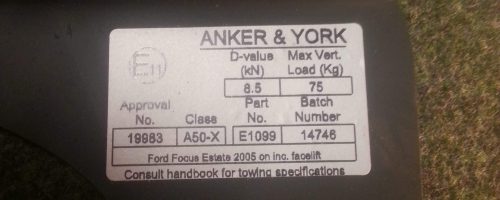Noseweight is a measurement of the vertical load (or downward force) placed on a vehicle’s towball from the caravan/trailer’s hitch (or coupling).
For stability while towing it’s important that the noseweight is correct. If your noseweight is too low, there’s not enough downward force on the car’s rear tyres and this can cause problems especially on rear wheel drive cars. Equally, if the noseweight is too high, it can put strain on the vehicle’s suspension or even cause the vehicle to ‘lift’ from the front.
The terms Noseweight, S Value, Vertical Load Limit and Tongue Load are all different terms for the same thing.
What is S Value?
S Value (or ‘Static Value’) refers to the maximum noseweight that a component (e.g. a towball or hitch) can take without failing. In other words it’s the mass that you can load onto the ball/assembly in a purely downward direction without it failing.
How do I Know what the Noseweight Should Be?
When you hitch (attach) a trailer or caravan onto a towball, a vertical force is pushing down on the ball – this is the noseweight. There is an ideal noseweight which ensures stability when towing. This is the noseweight you need to find.
Imagine a chainlink where each link represents a noseweight (or vertical load limit) of one of the main components involved when towing. Here’s a list of those components…
- Hitch
- Towball
- Vehicle
- Towbar
To find your optimum noseweight you need to find the weakest link in the chain i.e. you need to find the component which has the lowest noseweight limit.
No1 – The Hitch
Usually this will be stamped on the hitch. e.g. an Alko caravan hitch will usually have a noseweight limit of 100kg,
No2 – The Towball
A standard towball has a noseweight limit (referred to as S Value) of 200kg. You rarely have to worry about the Towball’s noseweight as it’s almost always higher than the other components.
No3 – The Vehicle
Regarding the vehicles recommended noseweight, I tried to find the recommended noseweight for a Ford Focus by searching the vehicle handbook but couldn’t find anything.
It’s supposed to be in the handbook but it won’t always be. In such cases you can call the dealership and they should tell you. Alternatively, the UK Caravan Club provided a table of Vehicle Noseweights on this link (page 4 – newer models might not be on here).
No4 – The Towbar
The towbar will be designed to cope with the vehicles noseweight limit (No3), but I recommend you also check the vehicle manufacturers noseweight recommendation because there are some cases where a particular towbar will fit more than one model/engine and variant could have different noseweight. e.g. a Bmw 3 series saloon may have a different noseweight to an estate even though the towbar is the same. The photo shows the towbar specs plate for a Ford Focus towbar; this tells us the Max vertical load is 75Kg.
Once you have all the figures….
Simple – Pick the lowest. The Vehicle’s Noseweight Limit is usually the deciding one. (i.e. set by the vehicle manufacturer and usually found in the handbook). Let’s say for example, it’s 75Kg.
Get yourself a good Noseweight Gauge, load up the caravan and read the weight on the gauge. You want to get as close to your noseweight limit as possible (in my case 75kg), without going over.
How to estimate a Caravan’s Noseweight?
Let’s say you’re buying a caravan and you need to know whether your vehicle will be suitable to tow it. An accepted practice is to estimate 5-7% of the caravan’s MTPLM (which is basically 5-7% of the laden weight). Modern caravans seem to be getting heavier, whereas vehicle noseweight limits are not, so I recommend you always check before choosing the caravan or car. It might well be that you need a bigger car.
How to Adjust The Noseweight
Move objects around.
Case 1 – Noseweight too high
Try to move things back towards the axle line of the caravan or trailer. You should not move things any further back than the axle as this can cause instability. If you’ve loaded across the axles and the weight is still too high, I’m afraid you will need to unload something.
Case 2 – Noseweight is too low
If your noseweight is too low, then you can move things forward to get more weight towards the towball and so increase the noseweight.
Conclusion
The above procedure might seem tedious/complicated, but the good news is that as long as your loads don’t drastically change e.g. what you take on holiday doesn’t fluctuate much, then you shouldn’t need to do it that often.

